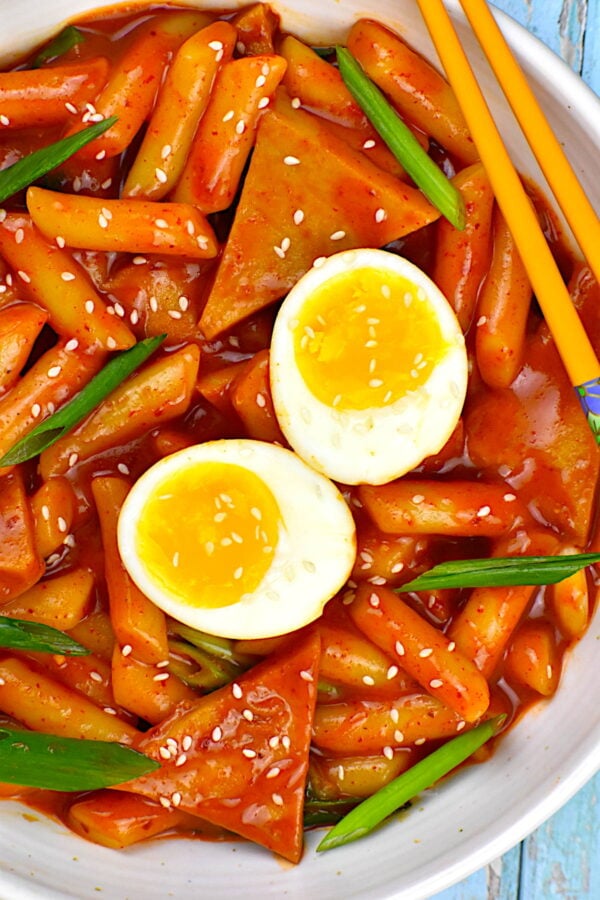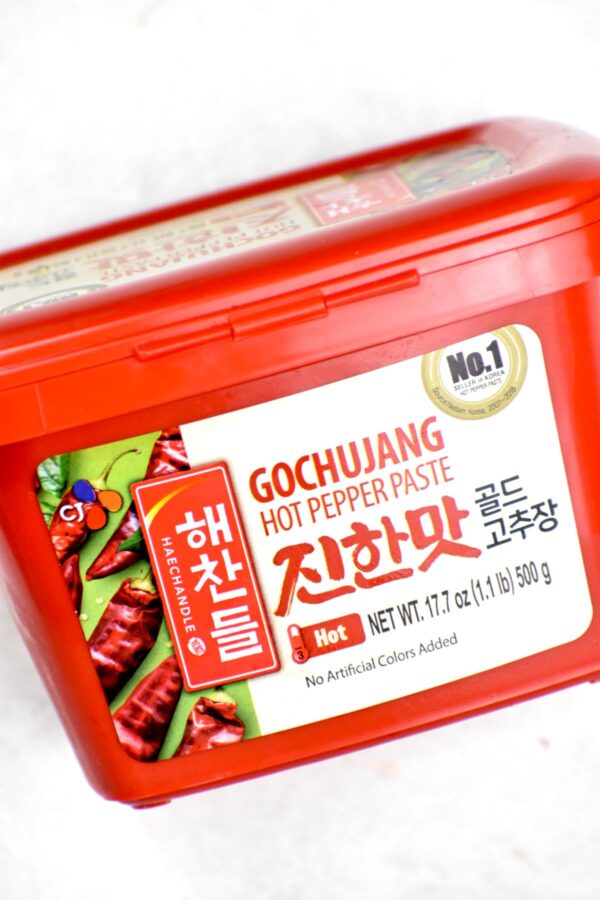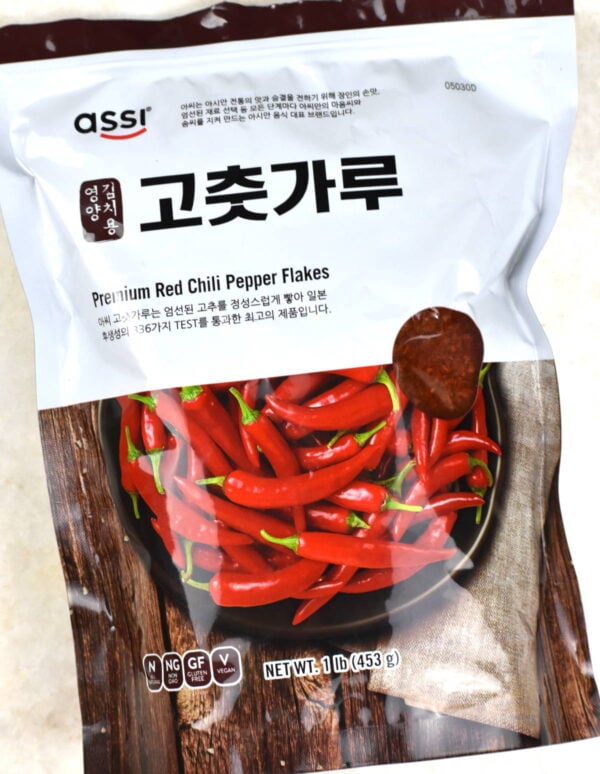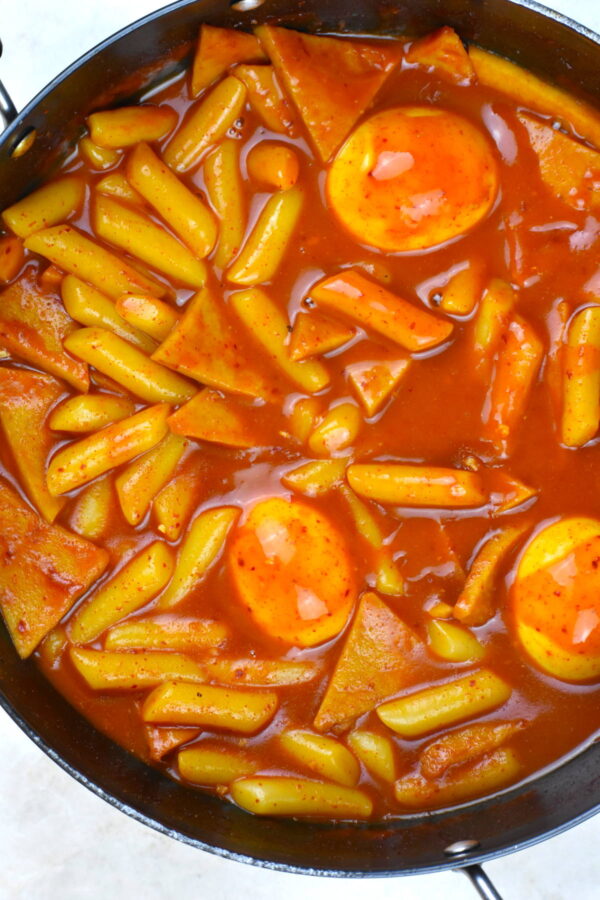These chewy rice cakes are a popular, spicy Korean dish loved by everyone, from street food stalls to cool cafes. It’s more than just food, it’s a big part of Korean culture. We’ve had some great Korean flavors going in GypsyPlate kitchen over the years. From our favorite Bulgogi and Japchae, to Korean Pork Soup and Ojingeo Bokkeum, we are discovering these cracking Asian flavors all the time. Now, I’ve wanted to make Tteokbokki for ages, as those bright red spicy flavors kept on enticing me. It was juts a matter of finding those Korean rice cakes and fish cakes in my local Asian grocery store. And now here is our version of Tteokbokki. It tastes just the way I always dreamt. Here we’re talking rice cakes simmered in a vibrant, spicy, savory sauce, acting like sponges absorbing wonderful flavors. Topped it with soft-boiled eggs, this is one meal you’ll want to put on repeat. Let’s get cooking and find out why Tteokbokki has taken Korea by storm.
What is Tteokbokki?
Tteokbokki is a popular Korean dish featuring chewy rice cakes cooked in a spicy, savory sauce. Literally translated as “stir-fried rice cake,” tteokbokki (떡볶이) is a beloved meal with many variations and a little history behind it. It’s also spelled ddukbokki, ddeokbokki, dukbokki or topokki. The sauce typically includes ingredients like gochujang (Korean red chili paste), gochugaru (Korean red chili flakes), soy sauce, and sometimes sugar. Tteokbokki has roots going back to the Joseon Dynasty, but the spicy version we know today gained popularity in the 1950s. Initially, it was a sautéed dish made with soy sauce, known as “Gungjung Tteokbokki,” enjoyed by the royal court. Post-Korean War, the current form quickly became a staple in Korean street food culture and spread its appeal globally.
Different Popular Types of Tteokbokki
Classic Spicy Tteokbokki: This is the most common form, featuring rice cakes in a spicy sauce made primarily from gochujang. Gungjung Tteokbokki: Also known as “royal court” Tteokbokki, this version uses soy sauce instead of gochujang, offering a less spicy, more savory flavor profile. It often includes vegetables and beef. Cheese Tteokbokki: Imagine a gooey layer of melted cheese on top of the spicy rice cakes. This modern twist adds a creamy, cheesy element that perfectly balances out the spiciness. Ra-bokki: This is Tteokbokki plus ramen noodles. We also have a great Rabokki recipe. Seafood Tteokbokki: Loaded with various kinds of seafood like shrimp, squid, and mussels, this version brings oceanic flavors into the spicy, comforting dish. Rose Tteokbokki: This luscious variant blends the spicy gochujang sauce with a creamy tomato base, featuring ingredients like heavy cream or milk. The result is a delightful “rose” colored sauce that strikes a balance between spicy and creamy.
Ingredient Notes
Tteokbokki (Korean Rice Cakes)
These chewy, cylindrical rice cakes are the star of the Tteokbokki. Available in fresh, frozen, and dried forms, they absorb flavors like a sponge, giving the dish its signature taste and texture. The size can vary, with smaller versions cooking faster than others. Fresh is ideal for immediate use, while frozen and dried varieties have longer shelf life but may require thawing or soaking. You’ll typically find them in Korean grocery stores, but they’re becoming more widely available in international sections of mainstream markets. If you have access to a Korean grocery store, I highly recommend using fresh rice cakes. They have the best texture, and provide the most authentic Tteokbokki experience.
Sheets of Fish Cakes (Optional)
Fish cakes, known as “eomuk” in Korean, add a seafood twist to Tteokbokki. These processed seafood sheets are made from a blend of white fish, starch, and various seasonings. Available in frozen or refrigerated forms, they can be cut into strips or triangles in this recipe. While optional, traditionally they’re part of the dish.
Gochujang (Korean Chili Paste)
Gochujang is a thick, spicy-sweet paste made from red chili peppers, glutinous rice, fermented soybeans, and salt. It has a deep, complex flavor profile that gives umami, sweetness, and heat. You should be able to find it in the international section of well-stocked supermarkets.
Gochugaru (Korean Red Chili Flakes)
Gochugaru, the ground form of sun-dried Korean red chilies, is the spice that kicks your Tteokbokki up a notch. Unlike your average chili flakes, gochugaru has a unique balance of sweet and smoky heat.
Other Ingredients:
Chicken Stock or Anchovy Stock: Anchovy stock is more traditional, but chicken or vegetable stock works wonderfully too as a sub. Soy Sauce: Adds saltiness. Sugar: Balances out the spiciness. You can use brown sugar instead. Garlic: We used freshly minced. Soft-Boiled Eggs: A must for any Asian noodle recipe! Scallions: For garnish and freshness. Sesame Seeds: Also for garnish.
Tteokbokki Recipe
- Prep the Rice Cakes: If your rice cakes aren’t fresh and soft, soak them in tap warm water for 15 minutes while you gather your other ingredients.
- Prepare Fish Cakes: Cut the fish cake into strips and then into small triangles.
- Make the Tteokbokki Sauce: In a small bowl, mix together the gochujang, gochugaru, soy sauce, sugar, and minced garlic.
- Make Seasoned Stock: Add your choice of chicken or anchovy stock to a wide pot or pan. Stir in the Tteokbokki sauce until well combined. Bring to a simmer over medium-high heat.
- Add Rice and Fish Cakes: Once the seasoned stock is boiling, toss in the rice cakes and fish cakes.
- Simmer: Reduce heat to medium-low and let it simmer for 10-15 minutes, stirring occasionally. While it’s simmering, check out our collection of favorite Korean Recipes.
- Final Touches: In the last few minutes, add the soft-boiled eggs and scallions. Cook for an additional minute or two.
- Garnish and Serve: Sprinkle sesame seeds and remaining scallions over the top, and your Tteokbokki is ready to enjoy.
Alpana’s Tips and Tricks:
Choosing the Right Rice Cakes: Go with fresh rice cakes if possible, but if you’re using dried or frozen, make sure to soak them in warm water until they soften. Spice Level Adjustments: If you find gochujang and gochugaru too spicy, feel free to adjust the amounts. Fish Cakes: If you’re not a fan of fish cakes, or if you’re catering to a more selective palate, feel free to skip them. You’ll still end up with a tasty dish. Add Veggies: Want to up the nutritional value? Throw in some vegetables like cabbage, carrots or bok choy for added crunch and color. Thickening the Sauce: If you like a thicker sauce, simmer it a little longer but watch closely to avoid it becoming too sticky.
Leftovers and Storing
Storing leftover Tteokbokki is a breeze! Once it cools down to room temperature, transfer it to an airtight container and refrigerate for up to 2-3 days. While freezing is an option, be warned that the texture of the rice cakes may change upon reheating. When you’re ready to enjoy it again, a quick zap in the microwave or a brief simmer on the stovetop will do the trick. If the sauce has thickened, simply add a splash of water or stock to get it back to its original consistency. So there you go, one more authentic Asian flavor in your kitchen. Make Tteokbokki, and see for yourself what all the fuss is about. It’s a celebration of bold Korean flavors. I guarantee, once you’ve tried this, Tteokbokki will secure a regular spot on your menu. As for me, I am already planning on my next rice cake game – Rabokki!! 🙂
Tteokbokki, on our Gypsy Plate… enjoy!
More great Asian recipes:Filipino Pork AdoboJapanese Beef CurryChicken CalderetaThai Chicken LarbVietnamese Chicken Curry



















